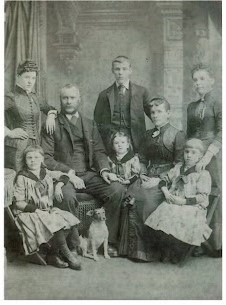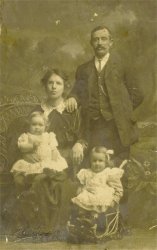Conflict in the community 120 years ago
A policeman’s lot is not a happy one, so the Gilbert and Sullivan song goes. And Hunstanworth’s village bobby in the early 1880s ensured school teacher Donald Campbell’s lot wasn’t so good either.
The school log books – records kept by the teacher to note down lessons taught, absences, punishments and other incidents – show that from July 1881 Mr Campbell was having trouble with an unruly pupil: “John Dan Nichol tore James Lowdon’s jacket. Altogether these Nichols are the most incorrigible lot I have ever had anything to do with.”

The Nichols c 1890: PC Dan Glaister Nichol, Number 165, with his wife Mary (nee Stamper) and children (back, l – r) Barbara, John Dan, Ruth, (front, l- r) Mary Ellas, Emily and Clara, Deirdre Beaton’s Grandmother. Deirdre Beaton.
John Dan’s challenging behaviour continues, and far from supporting the teacher in disciplining his son, father Dan Glaister Nichol – who just happens to be the local policeman – is defending him. Another entry by Campbell reads: John Dan Nichol throwing John Peadon’s hat into the water – though it is impossible to keep this boy in order owing to my being threatened by his father with a prosecution if I chastise him.
When John Dan Nichol is later about to be expelled for throwing stones at the school door, the boy threatens to tell his Dad because Campbell has chastised him. And a full year later the Nichols continue to be a thorn in the teacher’s side: John Dan Nichol again unruly. His father came bullying to the school about him and as usual threatening great things.
Into 1883 and 1884, more angry entries in the log books from Donald Campbell: John D Nichol struck Thomas Reddie on the ear. , …also left school while teacher out of room… …kicked William Robson on shin… and …bled Caroline Whitfield’s nose.
The school logs give us this brief glimpse into this clash of personalities of more than 120 years ago, showing that parenting – and indeed teaching – was no easier in Victorian times than it is now. But thanks to the wonders of the Internet, PC Nichol’s great-granddaughter, Deirdre Beaton, has been contacted in Australia, and she has been able to tell us a bit more about the Nichol family.
By the time 39-year-old Cumbrian Dan Glaiser Nichol moved to Ramshaw House, Hunstanworth in 1880 with his wife Mary and three children, he’d served with Durham Constabulary for 10 years. Before that he’d been a plain clothes officer with the Manchester and Cumberland Police, having been present at the arrest in Manchester of Fenians or Irish nationalists Colonel Thomas Kelly and Captain Timothy Deasy, two men who played an important part in the failed Fenian Rising of 1867.
The Durham Constabulary had been formed just 40 years earlier, and the uniform of blue tailed coat, thick trousers, black boots and top hat – reinforced with a cane frame to protect the wearer’s head if attacked – had to be worn at all times, even when off duty. In addition each officer was issued with a truncheon, handcuffs, lantern, knapsack, journal and instruction book.
PC Nichol had already been stationed at Sunderland Bridge, Shincliffe, Sherburn Hill, Oakenshaw, Boyne and Kelloe before he arrived at Hunstanworth. His record by this time was not spotless; while in Oakenshaw, PC Daniel Glaister Nichol, Number 165, had been fined five shillings and cautioned …for drinking in a public house on his beat, not attending his place of conference and making false entries in his journal. Several years later, after having moved on to Hetton Downs, he was fined five bob and cautioned for …drinking in a public house when on duty.
We shouldn’t be too hasty to judge PC Nichol, says Harry Wyme of the North East Police History Society: alcohol was the scourge of the Victorian police forces, and drinking while on duty was a common offence. Harry said: They didn’t have tea or coffee, and the water wasn’t generally fit to drink; beer was often the only refreshment available to them. Pub landlords could also be fined for serving an on duty officer on their premises.
Neither did the frequent transfers from one town to another mean the Nichols necessarily had difficulty ‘fitting in’. Policemen were often deliberately moved every couple of years so that they did not become integrated into the community, said Harry, and therefore didn’t form friendships and affiliations. That way their position as law enforcers was less likely to be compromised, he said.
Life as a rural police officer was tough; the beat would be covered on foot, up to 20 miles a day. Twelve hour shifts could be split into four hours on, four hours off, and so on, spread over a 24 hour period. They would routinely be on the look-out for poachers, tramps that were drifting through the patch and petty theft. If an officer was married, as Dan Glaister Nichol was, his wife would be expected to muck in by taking messages, even feeding a prisoner if someone was being held in the local lock-up.
There must have been a sigh of relief from the schoolhouse when the Nichols moved off to Hetton Downs in 1884 – not least because in addition to John Dan, Barbara and Ruth, there were another three Nichol children who would attend the school when they were old enough.
In March 1892 PC Daniel G. Nichol, Number 165 had served Each after upwards of 20 years’ long and faithful service with good conduct. This entitled him to wear the ‘Long and Faithful Service’ badge and draw extra pay. Harry Wyme says the Service badge was a little scroll worn on the left elbow, the recipients also earning an extra sixpence a week.
Dan Glaister Nichol retired from the police force after serving more than 26 years, and died in 1911 at the age of 71. His great-grandson Alan Nichol said the young Dan Glaister seems to have been abandoned at Wigton Workhouse when his mother Ruth married and moved to Dumfries in 1845, where she died of TB 11 years later.
How Did Dan Turn Out?
John Dan and his wife Mary with their children in 1915. Alan Nichol
What became of the little boy that gave his teacher so much grief? John Dan’s trail seemingly ran out in 1901 when the census showed he was living in Hetton Downs with his wife Mary and daughter Emily.
But in early October 2008 John Dan’s grandson, Alan Nichol, stumbled across the Hunstanworth History website by chance and got in touch from his home in Australia. He says: “I read the article with great amusement and considerable interest, as PC Nichol is my great-grandfather. I never knew my grandfather John Dan, but I can add that my father was a very religious man, a non-drinker and widely regarded as a thorough gentleman.
“John Dan joined the Royal Army Medical Corps at the commencement of WWI. His record shows he served in the Balkans, but family legend has it that he also served in India. He returned to England with malaria from which he died in 1920.”
John Dan in 1918, visibly frail after contracting malaria while serving with the Royal Army Medical Corps. Alan Nichol
Click here to learn how the Nichols make the move to Australia – John Dan’s grandson takes up the story.






